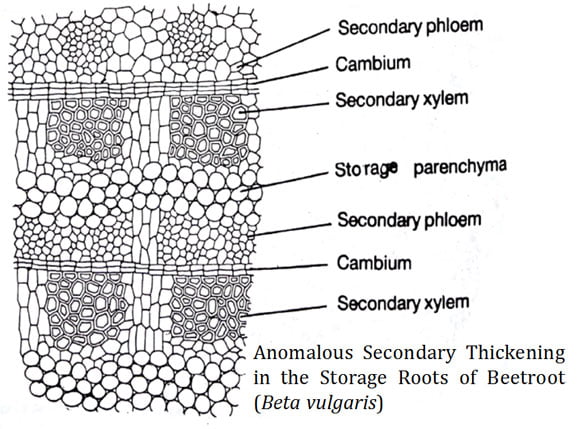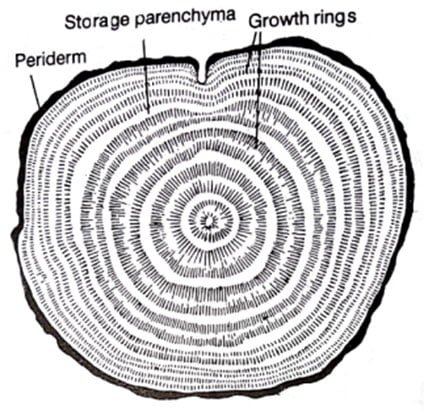In many dicots, the root functions as a storage region. The secondary growth in these storage roots is usually anomalous type. Example: Secondary thickening in Beta vulgaris (Beetroot – Chenopodiaceae) and Secondary thickening in Ipomoea batatas (Sweet potato – Convolvulaceae) The present post discusses the Anomalous Secondary Growth in Beetroot storage roots (Beta vulgaris).

Anomalous Secondary Growth in Beetroot
Primary structure
Ø The primary structure is a typical cotyledons type root with radial-diarch stele.
Ø Due to the storage nature of the roots, the cell number is increased in all the parts.
Ø In beetroots, the secondary growth takes place by (1). The abnormal activity of the cambium and (2). The abnormal position of the cambium
Secondary Structure
Ø The secondary growth is initiated by the formation of a cambial ring.
Ø The cambial ring is formed from the cells of pericycle outside the proto-xylem and parenchyma between the xylem and phloem.

Ø The primary cambial ring behave abnormally, it produces:
$ Inner side: Secondary xylem and parenchyma in alternate groups.
$ Outer side: Secondary phloem opposite to the secondary xylem and parenchyma opposite to inner parenchyma.
Ø This result in the formation of a ring of conjoint, collateral vascular bundles embedded in parenchymatous cells.
Ø The parenchyma cells function as the storage region.
Ø The cambium after sometime ceases its activity.
Ø Then, a second ring of cambium (accessory cambium) arises just outside the first (from the phloem parenchyma cells or outer ring of pericycle).

Ø The second ring of cambium also behaves abnormally as the first ring.
Ø Produce a ring of conjoint, collateral vascular bundles embedded in parenchymatous cells.
Ø These vascular bundles are separated by wider parenchymatous gaps which function as the storage region.
Ø The first accessory ring of cambium also ceases its function and additional cambial rings are successively formed.
Ø Towards the later stages, the developing cambial rings enclose a few layers of pericycle cells with are meristematic in nature.
Ø These meristematic cells divide rapidly to form multilayered parenchymatous cells.
Ø These parenchymatous cells then function as the storage region.

Ø They get filled with the food materials.
Ø With the passage of time, more and more proliferative parenchymatous cells are formed.
Ø Due to the formation of proliferative parenchyma, the vascular bundles get separated further apart.
Ø Subsequent cambial ring formation results in the production of vascular bundles and proliferative parenchymatous cells.
Ø All these proliferative parenchyma cells get filled with reserve food materials.
Ø In a cross-section through the storage portion of the root, the parenchymatous ring appears as dark red (due to the presence of anthocyanin pigments) whereas, the vascular bundle ring appear as light in colour.
Ø In the mature root, bark formation also occurs.
<<< Back to PLANT ANATOMY Notes
You may also like…
@. Dracaena: Secondary Thickening
@. Aristolochia Secondary Thickening
@. Mirabilis: Secondary Thickening
@. Amaranthus: Secondary Thickening
@. Dicot Root Secondary Thickening
@. Monocot Root Secondary Thickening
